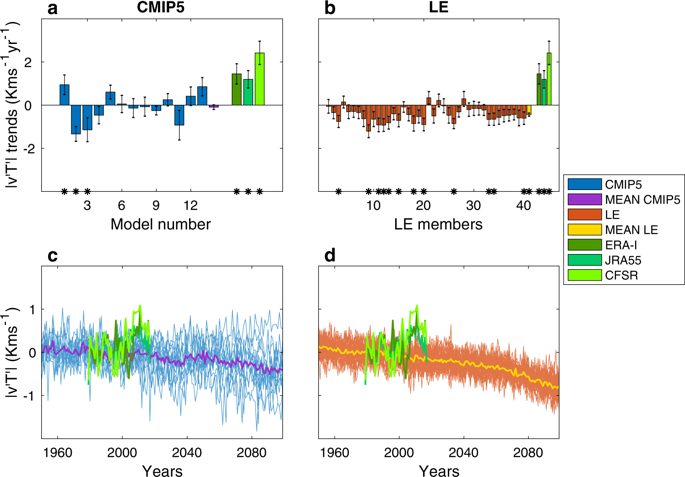npj Climate and Atmospheric Science ( IF 9 ) Pub Date : 2020-02-19 , DOI: 10.1038/s41612-020-0111-7 Rei Chemke , Lorenzo M. Polvani

|
Eddy heat fluxes play the important role of transferring heat from low to high latitudes, thus affecting midlatitude climate. The recent and projected polar warming, and its effects on the meridional temperature gradients, suggests a possible weakening of eddy heat fluxes. We here examine this question in reanalyses and state-of-the-art global climate models. In the Northern Hemisphere we find that the eddy heat flux has robustly weakened over the last four decades. We further show that this weakening emerged from the internal variability around the year 2000, and we attribute it to increasing greenhouse gases. In contrast, in the Southern Hemisphere we find that the eddy heat flux has robustly strengthened, and we link this strengthening to the recent multi-decadal cooling of Southern-Ocean surface temperatures. The inability of state-of-the-art climate models to simulate such cooling prevents them from capturing the observed Southern Hemisphere strengthening of the eddy heat flux. This discrepancy between models and reanalyses provides a clear example of how model biases in polar regions can affect the midlatitude climate.
中文翻译:

将中纬度涡流热通量趋势与极性放大联系起来
涡流在将热量从低纬度传递到高纬度方面起着重要作用,从而影响中纬度气候。最近和预计的极地变暖及其对子午温度梯度的影响表明,涡流通量可能会减弱。在这里,我们通过重新分析和最新的全球气候模型来研究这个问题。在北半球,我们发现过去四十年来,涡流的热通量已经大大减弱。我们进一步表明,这种减弱来自2000年前后的内部变化,我们将其归因于温室气体的增加。相反,在南半球,我们发现涡流的热通量得到了强有力的增强,并将这种增强与最近南海表面温度的多年代际降温联系起来。最新的气候模型无法模拟此类降温,从而阻止了它们捕捉到南半球涡流热通量的增强。模型与再分析之间的差异为极地地区的模型偏差如何影响中纬度气候提供了一个清晰的例子。



























 京公网安备 11010802027423号
京公网安备 11010802027423号